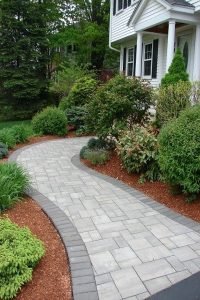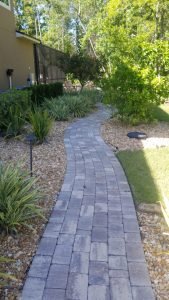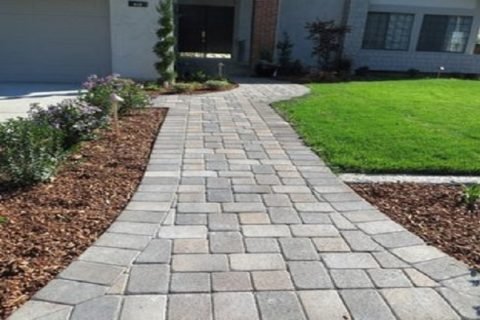Landscape architects, designers, and manufacturers in some cases make a differentiation between the terms walkway and pathway. Walkways are utilitarian cleared surfaces used to encourage pedestrian activity for all intents and purposes. They are frequently straight courses, typically produced using hard clearing materials. A pathway, then again, can be viewed as an increasingly recreational element of a scene, a wandering course, frequently produced using easygoing, rural materials.

Pathways are suitable for progressively characteristic settings, for example, gardens, where they give a way to getting a charge out of scene includes at relaxation. Walkways, then again, will in general be all business—intended to move individuals from guide A toward point B with at least complain.
Contrasts Between Walkways and Pathways
The sorts of materials used to fabricate pathways are normally not the same as those used to build walkways. Normal materials, for example, free rock or mulch are regular decisions in pathways, while walkways are generally shaped from stable hardscape materials, for example, poured solid, huge chunks of mortared stone, or pavers.
In spite of the fact that poured concrete is regularly the material of decision for walkways, pavers make for a greatly improved walkway surface. Produced using tumbled solid squares, pavers look more normal than poured concrete and are accessible in different earth tones for better coordination into the scene. They additionally are safe to the splitting that can torment strong solid walkways. In the event that a paver is harmed, it is a simple issue to expel and supplant it.
A last basic contrast among walkways and pathways is their width. Walkways are commonly four to six feet wide to take into account walkers to pass by each other, while pathways are normally a few feet wide in light of the fact that they are utilized less frequently and by less individuals.
Plan Considerations for Walkways and Pathways
Attempt to keep walkway structure predictable. On the off chance that you have a proper home, symmetric lines might be ideal. Or on the other hand, in the event that you have a nation style home, think about utilizing huge flagstones for a progressively regular look. Mortgage holders need to remember such subtleties as climate conditions and expected uses for the walkway or way while talking about a venture with their exterior decorator, as this may help figure out what structure standards are best for their space.
Configuration Trends
In walkway development, corrosive recoloring and stepping concrete have as of late become extremely mainstream patterns, offering financially savvy approaches to improve standard poured concrete. Be that as it may, these strategies won’t keep going forever and regularly require yearly support. Corrosive stains can be applied to previous solid, making this a savvy choice for property holders trying to revamp existing solid walkways. Corrosive recoloring is in some cases done effectively by DIYers.
Another strategy for shading concrete is coloring. There are about 40 to 50 solid color hues from which to pick, yet this procedure is best when it is blended into enormous bunches in a prepared blend truck. Enormous scope coloring isn’t down to earth for the DIYer. Stepping concrete is likewise best done by experts.
While picking a shading for recolored or colored solid, coordinate the walkway with the shade of the house. Regularly, earth-tone hues give a decent supplement to the home’s outside. When planning a pathway, ensure the hues are normal and mix with the environmental factors.
To keep up a decent appearance when stepping or coloring solid, utilize a business sealer after fruition. You can pick either a lustrous or a dry hope to improve the shading. A business sealer can likewise forestall shape and mold development and help keep climate from separating materials.
Arranging Considerations
A few issues ought to be viewed as while picking materials for a walkway or pathway:
Spending plan. The financial plan a mortgage holder has saved for the venture is the biggest factor while choosing materials for a walkway or pathway, as cost directs what materials are accessible to utilize.
Shade. The measure of shade present is another deciding component when choosing which materials to use in walkways and pathways. Greenery and mold will aggregate on stone and solid, causing an elusive, perilous condition. Use trail blend—a characteristic blend of totals—for pathways in obscure regions for pathways. For walkways in conceal, use pavers as opposed to poured concrete.
Home development. Take a gander at the house’s hues and siding. Is it block? Plaster? Wood siding? When building up a walkway, attempt to choose a shading that supplements existing structures, yet doesn’t coordinate them precisely. For instance, if your home has a block outside, select one color found in the block dividers to remember for the walkway. This is the reason earth tones are so famous—in light of the fact that they frequently supplement customary structure materials. For pathways, this isn’t as troublesome on the grounds that you are regularly putting the pathway in an extremely common setting between trees or a nursery. Destroyed wood, rock, and other regular materials frequently work best in these circumstances.

Land Value
Pathways and walkways make an expansion of the home by making unusable spots usable. While giving down to earth living worth, these highlights can likewise build land esteem. Whenever done effectively, a quality pathway or walkway venture made with great materials is a wise speculation. A half-baked or executed walkway, then again, could decrease the estimation of your home. A scene architect can reveal to you whether the venture merits the possible expense.
While stone ways now and again are laid in mortar, this requires a solid establishment and involvement in stone brick work. A basic sandset way is a lot simpler and is ideal for DIY establishment. With this procedure, the stones are basically laid onto a bed of sand, which keeps the stones stable and makes it simple to get everything level. At the point when you’re set, you can occupy the spaces between the stones with sand or rock or even plants that can endure pedestrian activity.
Picking stone for a walkway is for the most part a matter of taste, as any wide, level stones will do. Most walkways are made with flagstone, which depicts a state of stone as opposed to a particular kind of rock. It’s typically best to pick a sort that is locally accessible, as this holds the expense down, both for the stone and the conveyance. Ensure any stone you use has a characteristic surface and is sufficiently thick to be solid (don’t utilize cleaned stone, which is dangerous when wet). Most flagstone that is 2 to 3 inches thick is perfect. Thicker stones are more grounded and heavier than more slender pieces; they’re additionally frequently more affordable, because of their weight.





